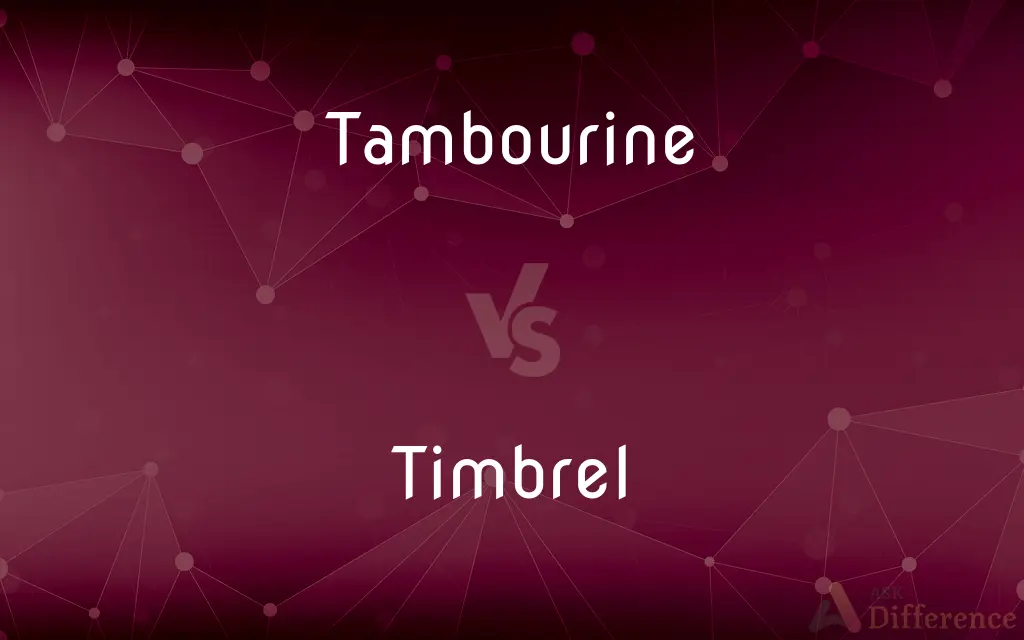Tambourine vs. Timbrel — What's the Difference?
By Tayyaba Rehman — Updated on November 3, 2023
A tambourine is a percussion instrument with jingles, used in many genres; a timbrel is an ancient form of tambourine, often mentioned in religious texts.

Difference Between Tambourine and Timbrel
Table of Contents
ADVERTISEMENT
Key Differences
A tambourine is a musical instrument in the percussion family known for its circular frame with pairs of small metal jingles called zills. The timbrel, historically a term used interchangeably with tambourine, is an ancient instrument often referenced in religious texts, such as the Bible. The tambourine is used across various musical genres, whereas the timbrel is typically associated with ancient or religious music.
The modern tambourine can be found in classical orchestras, folk music bands, and rock concerts. Conversely, the timbrel, while similar in design, is often seen as the predecessor to the contemporary tambourine and is less common in modern music. Both the tambourine and timbrel consist of a frame, membranes, and sometimes jingles, but their cultural contexts differ.
When played, the tambourine may be struck with the hand, shaken, or hit against another part of the body to create rhythm. The timbrel, in its historical context, was used in similar ways but often in religious ceremonies or rituals. The tambourine's rhythmic capabilities make it a versatile instrument, whereas the timbrel's use is more specific to its cultural and historical applications.
The construction of tambourines can vary, with some having a head made of animal skin or synthetic materials, while others are headless with just jingles. The timbrel traditionally would have been made with organic materials available at the time, such as animal skin. Both tambourines and timbrels are handheld instruments, but tambourines have evolved to include more durable and varied materials.
In terms of etymology, the word "tambourine" comes from the French word 'tambourin,' whereas "timbrel" derives from the late Latin 'tympanum,' which refers to a hand drum. The tambourine is commonplace in music shops and educational settings; the timbrel is now more a term of historical or biblical significance rather than a common term in contemporary music lexicon.
ADVERTISEMENT
Comparison Chart
Historical Usage
Used across many cultures and times, modern and widespread.
Predominantly ancient, with specific references in scripture.
Cultural Association
Diverse, from classical to pop music.
Strongly associated with religious and ancient ceremonies.
Material Construction
Modern materials like plastic and synthetic skins.
Historically made from organic materials like animal skins.
Prevalence in Modern Music
Commonly found in various music genres today.
Rarely used, mostly referenced historically.
Etymology
From the French 'tambourin'.
From the late Latin 'tympanum', related to hand drum.
Compare with Definitions
Tambourine
A percussion instrument with jingles
The child joyfully played the tambourine in the music class.
Timbrel
An ancient percussion instrument similar to a tambourine
The painting depicted women playing the timbrel in celebration.
Tambourine
Can be played by striking, shaking, or hitting
During the concert, the drummer hit the tambourine with flair.
Timbrel
Often mentioned in religious contexts, especially in the Bible
Miriam played the timbrel as she led the women in dance.
Tambourine
An instrument often used in folk and pop music
The band's upbeat song featured a tambourine in the chorus.
Timbrel
Associated with ancient rituals and ceremonies
The timbrel was central to their traditional harvest festival.
Tambourine
The tambourine is a musical instrument in the percussion family consisting of a frame, often of wood or plastic, with pairs of small metal jingles, called "zills". Classically the term tambourine denotes an instrument with a drumhead, though some variants may not have a head.
Timbrel
A hand-held instrument with jingles used in historical music
He demonstrated how the timbrel was used in medieval times.
Tambourine
A percussion instrument resembling a shallow drum with metal discs in slots around the edge, played by being shaken or hit with the hand.
Timbrel
The term 'timbrel' conveys a sense of antiquity in music
Scholars discussed the timbrel's role in ancient worship practices.
Tambourine
A percussion instrument consisting of a small drumhead with jingling disks fitted into the rim, usually played by shaking and striking with the hand.
Timbrel
The timbrel or tabret (also known as the tof of the ancient Hebrews, the deff of Islam, the adufe of the Moors of Spain) was the principal percussion instrument of the ancient Israelites. It resembled either a frame drum or a modern tambourine.
Tambourine
A similar instrument without a drumhead.
Timbrel
A tambourine or similar instrument.
Tambourine
A tambourine dove.
Timbrel
An ancient percussion instrument similar to a tambourine.
Tambourine
A kind of Provençal dance.
Timbrel
An ancient percussion instrument rather like a simple tambourine.
Tambourine
The music for this dance.
Timbrel
(intransitive) To play the timbrel.
Tambourine
To play the tambourine.
Timbrel
(transitive) To accompany with the sound of the timbrel.
Tambourine
To make a sound like a tambourine.
Timbrel
A kind of drum, tabor, or tabret, in use from the highest antiquity.
Miriam . . . took a timbrel in her hand, and all the women went out after her with timbrels and with dances.
Tambourine
A small drum, especially a shallow drum with only one skin, played on with the hand, and having bells at the sides; a timbrel.
Timbrel
Small hand drum similar to a tambourine; formerly carried by itinerant jugglers
Tambourine
A South American wild dove (Tympanistria tympanistria), mostly white, with black-tiped wings and tail. Its resonant note is said to be ventriloquous.
Tambourine
A shallow drum with a single drumhead and with metallic disks in the sides
Tambourine
A hand-held drum with a membrane and metal discs
She tapped the tambourine to the beat of the song.
Tambourine
Varies in size and can be tuned or untuned
The musician chose a small, untuned tambourine for the acoustic set.
Common Curiosities
What genres feature the tambourine?
The tambourine is featured in folk, rock, classical, and many other music genres.
Are tambourines used in modern music?
Yes, tambourines are widely used across various modern music genres.
What is a tambourine?
A tambourine is a hand-held percussion instrument with a membrane and metal jingles.
What's the difference between a tambourine and a drum?
A tambourine has jingles and is usually played with hands, while a drum typically has a larger surface and is played with sticks.
What is a timbrel?
A timbrel is an ancient instrument, similar to a tambourine, often used in religious contexts.
Can a tambourine have a head?
Yes, tambourines can have a head made of animal skin or synthetic material.
Do timbrels still exist today?
Timbrels are rare today, mainly referenced in historical or religious texts.
Is the timbrel mentioned in the Bible?
Yes, the timbrel is frequently mentioned in the Bible, particularly in the Old Testament.
How is the timbrel used in historical studies?
The timbrel is studied in historical and ethnomusicological contexts to understand ancient music and culture.
Are tambourines easy to play?
Tambourines are relatively easy to play but can be mastered with skill and rhythm.
What cultural significance does the timbrel have?
The timbrel has cultural significance in ancient Jewish, Christian, and Middle Eastern cultures.
Do tambourines come in different sizes?
Yes, tambourines come in various sizes and types, some with tunable heads.
Was the timbrel played similarly to the tambourine?
Yes, the timbrel was played by shaking, striking, or hitting, similar to the tambourine.
Is the timbrel typically made from animal skin?
Historically, the timbrel was often made with animal skin, but representations vary.
How has the tambourine evolved over time?
The tambourine has evolved to include more durable materials and is used in a wider variety of musical settings than the timbrel.
Share Your Discovery

Previous Comparison
Scratch vs. Nick
Next Comparison
Yam vs. CassavaAuthor Spotlight
Written by
Tayyaba RehmanTayyaba Rehman is a distinguished writer, currently serving as a primary contributor to askdifference.com. As a researcher in semantics and etymology, Tayyaba's passion for the complexity of languages and their distinctions has found a perfect home on the platform. Tayyaba delves into the intricacies of language, distinguishing between commonly confused words and phrases, thereby providing clarity for readers worldwide.















































